#portrait of pope francis ii
Text
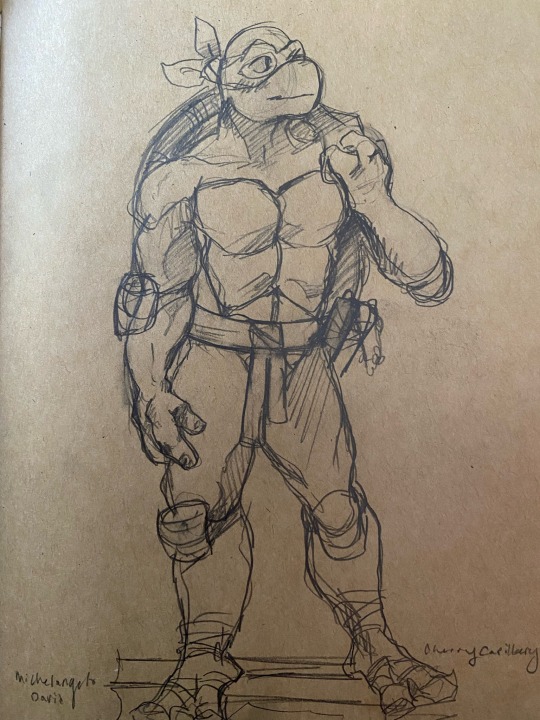
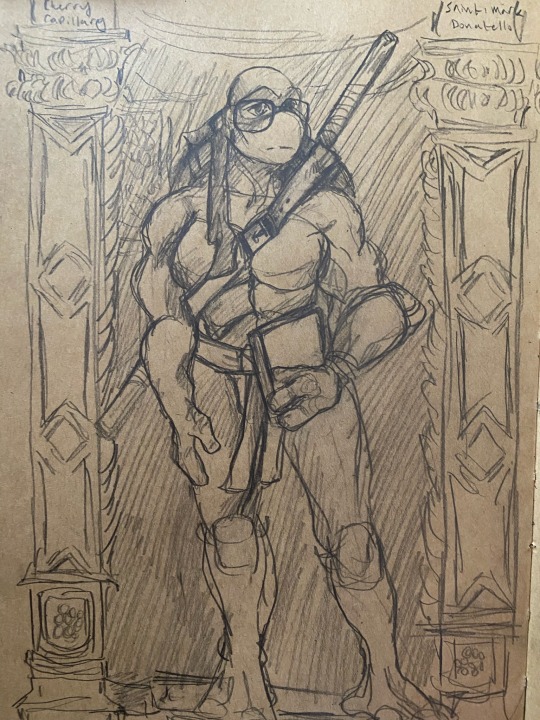
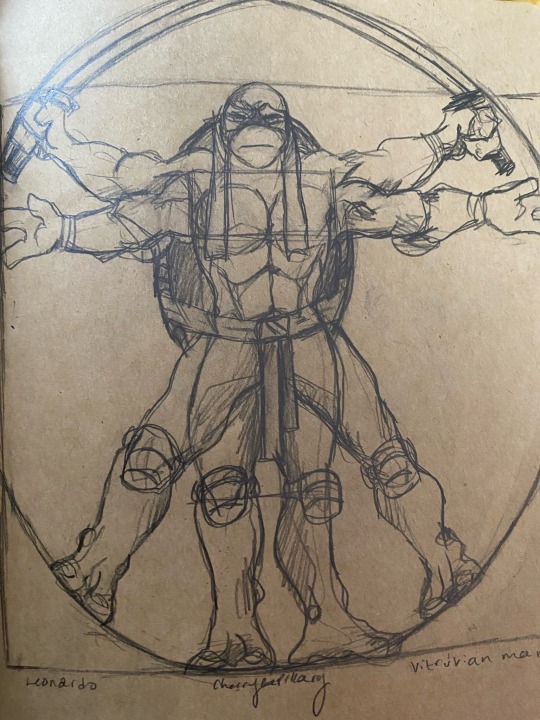
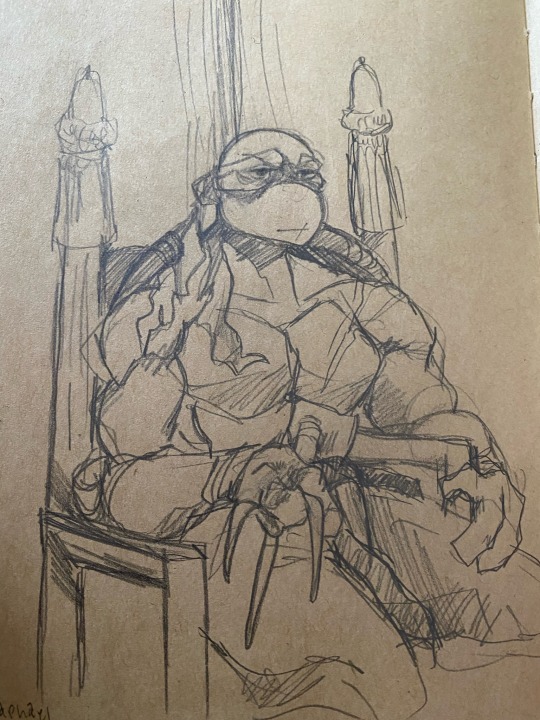
mikey as michelangelo’s david
donnie as donatello’s saint mark
leo as leonardo’s vitruvian man
raph as raphael’s portrait of pope julius ii
#my art#traditional#tmnt#teenage mutant ninja turtles#leonardo#donatello#michelangelo#raphael#portrait of pope francis ii#vitruvian man#saint mark#david#sketch#traditional art
876 notes
·
View notes
Text
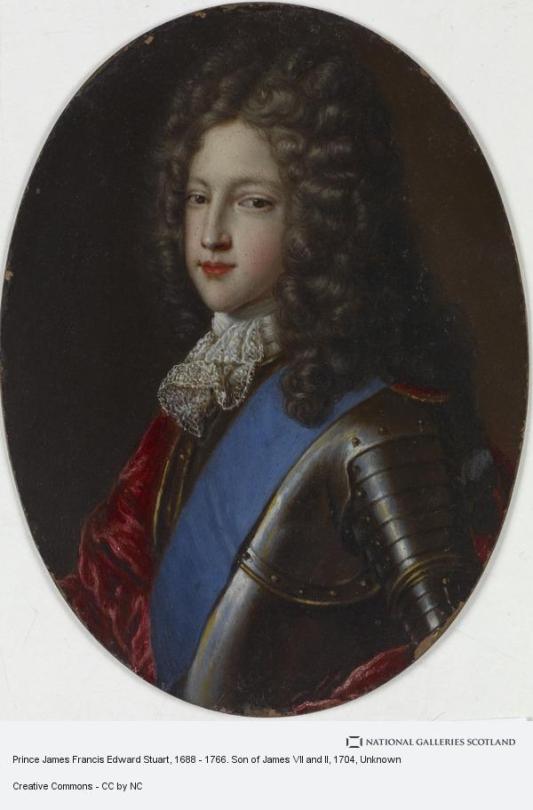




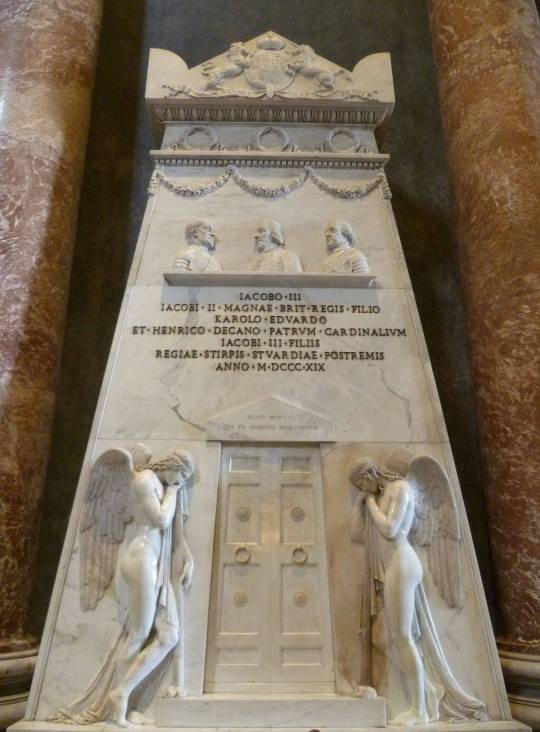
January 1st 1766 saw the death of James Francis Edward Stuart, in Rome.
Born after nine previous children died either at birth or shortly after and a tenth who died at age four, a rumour, likely started by Protestant partisans, was almost immediately spread that a living child had been smuggled into the birthing chamber in a warming pan after the royal child had been born dead. At birth he was created 1st Duke of Rothesay, styled as Earl of Chester and Prince James of Wales. He was also created 1st Duke of Cornwall.
Fearing another Roman Catholic monarch, a Protestant group invited James II’s Protestant daughter by his first marriage, Mary, to take the throne, supplanting both her father and half-brother. Her acceptance resulted in what became known as the Glorious Revolution of 1688.
James was raised in exile in France where he became the focus for Jacobites hopes. Upon his father’s death in 1701, he declared himself king and was recognized as the heir by several Roman Catholic monarchs, but was attainted for treason by Act of Parliament in March 1702 in Britain and his titles were forfeited under British law.
He attempted an invasion of Britain in March 1708, but his fleet was driven off. Another attempt was made in 1715 when he achieved landfall in Scotland but had missed the crucial Battle of Sherriffmuir disappointed by the lack of support instead of attempting a planned coronation at Scone, he retreated back to France.
By this time the French were at peace with Britain and he was no longer welcome in the country. He was invited by Pope Clement XI of the Palazzo Muti to make Rome his residence. In September 1719, he married Maria Sobieski and with her had two sons, Charles Edward and Henry. He presided over his Roman Jacobite court for the remainder of his life.
He died at age 77 in Rome. He was buried within the Vatican City, in what we know as The Monument to the Royal Stuarts. The marble monument is by Antonio Canova, the most celebrated Italian sculptor of his day. It is in the form of a truncated obelisk. It carries profile portraits of the three exiled princes, and the following inscription:
IACOBO·III
IACOBI·II·MAGNAE·BRIT·REGIS·FILIO
KAROLO·EDVARDO
ET·HENRICO·DECANO·PATRUM·CARDINALIVM
IACOBI·III·FILIIS
REGIAE·STIRPIS·STVARDIAE·POSTREMIS
ANNO·M·DCCC·XIX
(To James III, son of King James II of Great Britain, to Charles Edward and to Henry, Dean of the Cardinal Fathers, sons of James III, the last of the Royal House of Stuart. 1819)
Below the inscription are two weeping angels, symbolising the lost hopes of the exiled Stuarts.
11 notes
·
View notes
Text
Gotta say, the funniest moment in The Real O’Neals is when the grandma visits by surprise, so the family has to rush to redecorate their house in a way that would please her, and one of the things they do is replace their portrait of Pope Francis with one of Pope John Paul II.
44 notes
·
View notes
Note
Saw your photo post of Pope Benedict XVI and wanted to know if you know any books about him to share?
You know, I've always had at least a passing interest in Papal history, but what really got me fascinated in the history of the institution and its leaders and traditions was when Pope John Paul II died in 2005. I couldn't stop watching coverage of his funeral and, especially, the Conclave because neither of those things had ever happened in my lifetime. I'm not even Catholic -- or religious! -- but there I was hooked by the combination of majesty and mystery with the whole deal.
Then-Cardinal Ratzinger was the leading figure of the funeral ceremonies for John Paul II prior to that Conclave and he went into the Conclave as the leading candidate among the Papabile, so it was not surprise when he was quickly elected and became Pope Benedict XVI. Because of all that, I ended up with a lot of books about Pope Benedict (long since surpassed by the library of Pope Francis books I now have), and even quite a few books written by Benedict XVI. Unless you're really into learning about his theological philosophy, I'd skip most of the books that Ratzinger/Benedict wrote. The exception would probably be Pope Benedict XVI's encyclicals: God Is Love (Deus Caritas Est), Saved In Hope (Spe Salvi), and Charity In Truth (Caritas in Veritate), which I do find interesting. Plus, the Ignatius Press of San Francisco publishes each of the encyclicals in gorgeous little volumes that are nice to collect. Benedict was also working on another encyclical when he resigned in 2013 -- The Light of Faith (Lumen Fidei) -- which was completed and released by Pope Francis, but credited as the work of "four hands" and considered the only encyclical co-written by two Popes.
However, when it comes to the Popes, I've always been more interested in the biographical than ecclesiastical, and there is no shortage of great biographies about Benedict XVI. Elio Guerriero's 2018 biography, Benedict XVI: His Life and Thought (BOOK | KINDLE) is excellent. But the very best books about Pope Benedict are those written by Peter Seewald, who basically ended up as Benedict's official biographer and had incredible access to the German Pope. Seewald's 2008 book, Benedict XVI: An Intimate Portrait, is a solid starting place and takes you about halfway through his pontificate. Benedict XVI: Last Testament: In His Own Words (BOOK | KINDLE) from 2017 is basically a book-length interview of Benedict by Seewald. But the definitive work about Ratzinger is the two-volume biography Seewald recently published -- Benedict XVI: A Life, Volume I: Youth in Nazi Germany to the Second Vatican Council, 1927-1965 (BOOK | KINDLE), published in 2020, and Benedict XVI: A Life, Volume II: Professor and Prefect to Pope and Pope Emeritus, 1966-the Present (BOOK | KINDLE), which was published in 2021.
Two other titles are worth mentioning just because they are written from unique points of view. My Brother, the Pope (BOOK | KINDLE) was written by Benedict XVI's older brother, Georg Ratzinger, who was also a Catholic priest and died in 2020 at the age of 96. And John Paul II: My Beloved Predecessor is obviously not necessarily a book about Benedict, but it was written by him and provides an interesting glimpse of the relationship between then-Cardinal Joseph Ratzinger and Pope John Paul II. Oh...and I'd also suggest Anthony McCarten's The Two Popes: Francis, Benedict, and the Decision That Shook the World (BOOK | KINDLE), which was originally published as The Pope, and used as the basis for a great little movie starring Anthony Hopkins and Jonathan Pryce, as Benedict XVI and Francis respectively.
It might seem like I mentioned every book about Benedict XVI, but I promise I narrowed it down to the best ones in my library. If you're just looking for a good, comprehensive biography, go with any of the books by Seewald.
#Pope Benedict XVI#Pope Emeritus Benedict XVI#Benedict XVI#Papacy#Popes#Papal History#Books about Popes#Death of Pope Benedict XVI#Funeral of Pope Benedict XVI#History#Catholic Church#Religion#Religious History#Religious Leaders#Peter Seewald#Biographies#Elio Guerriero#Anthony McCarten#Papal Encyclicals
7 notes
·
View notes
Text

THE DESCRIPTION OF SAINT JOHN BOSCO (aka Don Bosco)
The Apostle, Father and Teacher of the Youth
Feast Day: January 31
"Enjoy yourself as much as you like - if only you keep from sin."
The founder of the Society of Saint Francis de Sales (popularly known as the Salesians of Don Bosco) was born Giovanni Melchiorre Bosco, to a peasant family in Castelnuovo d'Asti (Castelnuovo Don Bosco), Piedmont, Kingdom of Sardinia, twelve miles near Turin, Italy on the feast of the Assumption of Mary - August 15, 1815. He was the youngest son of Francesco Bosco and Margherita Occhiena, and had two older brothers, Antonio, and Giuseppe.
The Boscos of Becchi were farmhands of the Moglian Family, and John was born into a time of great shortage and famine in the Piedmontese countryside, following the devastation wrought by the Napoleonic Wars and drought in 1817.
In 1825, when he was nine years old, he dreamed of an army of youngsters, who turned from ferocious animals into gentle lambs. The Blessed Virgin Mary, with her hands on his head, said: 'What you have seen happen to these animals, you will have to do with my children.'
John started gathering the children of his town, teaching them catechism and bringing them to church. He would often delight them with acrobatic and circus tricks.
John was sixteen when he entered the seminary at Chieri, next to the Church of the Immacolata Concezione (San Fillippo). His parish priest was convinced of his vocation because John was able to repeat word by word all his homilies. After six years of study, he has ordained a priest on the eve of Trinity Sunday by Archbishop Franzoni of Turin in 1841 at the age of twenty-six.
John was assigned to Turin, where he energetically worked for the prisoners, the youth, and the street children. For them, he opened the Oratory of St. Francis de Sales, where they could learn a trade and the basics of Christian life. He chose this patron saint for his gentleness, and because in the hall of the house donated by a rich woman for his oratory, there was his portrait.
In his tireless apostolate, Don Bosco was constantly supported by his mother. In his effort to make honest citizens and good Christians, he opened workshops for shoemaking, tailoring, and printing. Don Bosco was so convinced of the power of the mass-media that he usually spent half of the night writing books and magazines. His motto was: 'Give me the souls and keep all the rest.'
In 1859, he founded the Salesian Society for the education of the boys; and in 1872, he founded the Daughters of Mary Help of Christians (Salesian Sisters of Don Bosco) together with St. Maria Domenica Mazzarello, for the education of the girls. In order to support the work of both congregations, John organized the Association of Salesian Cooperators in 1876, who followed in their homes and state of life of the Salesian spirituality.
Don Bosco died on January 31, 1888 in Turin at the age of 72 due to bronchitis, and his funeral was attended by thousands. He is beatified on June 2, 1929 and is canonized as a saint by Pope Pius XI on April 1, 1934 - Easter Sunday. His major shrine can be found at the Basilica of Our Lady Help of Christians in Turin, Italy.
In 2002, Pope St. John Paul II was petitioned to declare Don Bosco the Patron of Stage Magicians. John Bosco had pioneered the art of what is today called 'Gospel Magic,' using magic and other feats to attract attention and engage the youth.
#random stuff#catholic#catholic saints#salesians#salesians of don bosco#society of st. francis de sales#john bosco#don bosco#john melchior bosco#juan bosco#juvenile delinquents#magicians#gospel magic
1 note
·
View note
Text
Discover the Life and Art of Francis Bacon
Who is Francis Bacon? Francis Bacon was an Irish-born British figurative painter who was born in Dublin in 1909. He was one of the most influential and controversial artists of the 20th century, known for his distinctive style and powerful, often disturbing imagery.
A. Early Life Bacon was born to an English family in Dublin, Ireland, and grew up in England. He attended the London School of Economics but dropped out after a year to pursue a career in art.
B. Career and Achievements Bacon's career as an artist began in the 1930s, but he did not gain recognition until the 1940s. His works are characterized by their bold use of color, distorted figures, and emotional intensity. Bacon's most famous paintings include "Three Studies for Figures at the Base of a Crucifixion," "Study after Velázquez's Portrait of Pope Innocent X," and "Figure with Meat." Bacon was also awarded the Order of Merit, one of the highest honors bestowed by the British monarch, in 1987.
II. The Art of Francis Bacon Bacon's art is known for its distinctive style and characteristics.
A. Style and Characteristics Bacon's paintings often feature distorted, fragmented figures, and are characterized by their bold use of color and emotional intensity. He is known for his use of biomorphic shapes and his interest in the human body, which he explored through distorted and fragmented forms.
B. Famous Paintings Bacon's most famous paintings include "Three Studies for Figures at the Base of a Crucifixion," "Study after Velázquez's Portrait of Pope Innocent X," and "Figure with Meat." These works are characterized by their visceral imagery and raw emotional power.
III. Francis Bacon posters and paintings are highly sought after by collectors and art enthusiasts alike.
A. Meaning and Significance
A way to experience his art in a more accessible format. A Francis Bacon poster or painting can bring the provocative and emotive qualities of his work into your home or office, and allow you to appreciate his unique style and vision on a daily basis.
B. Where to Find and Buy Francis Bacon Artworks Francis Bacon posters and paintings can be found in a variety of Merchfuse, auction houses, and online marketplaces? It is important to do your research and only buy from reputable sellers to ensure the authenticity of the artwork. Some notable places to find and buy Francis Bacon artworks include:
Sotheby's and Christie's auction houses
Art galleries such as Gagosian, Marlborough, and The Estate of Francis Bacon
Online marketplaces such as Artsy, Saatchi Art, and Artfinder
IV. Conclusion In conclusion, Francis Bacon was a groundbreaking artist whose distinctive style and provocative imagery continue to captivate audiences today. His famous paintings, such as "Three Studies for Figures at the Base of a Crucifixion" and "Study after Velázquez's Portrait of Pope Innocent X," are iconic works of art that have had a lasting impact on the art world. By owning a Francis Bacon poster or painting, you can bring the power and intensity of his art into your own space and appreciate his unique vision on a daily basis.
Check out our website for buying exhibition posters and Paintings. Merch Fuse.
0 notes
Photo
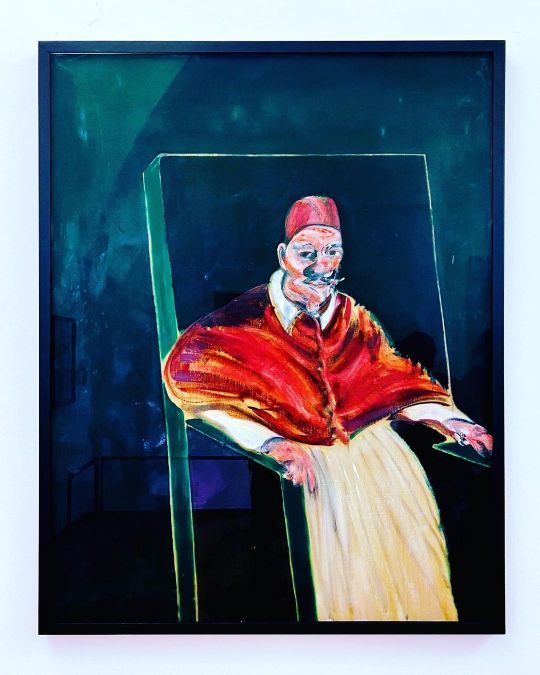
Study for Velazquez Pope II, 1961 by Francis Bacon Realized in 1961 for the series Study for a Pope I-VI, the painting forms part of the research Bacon had initiated many years earlier, aimed at reworking Velázquez’s 1650 work Portrait of Innocent X. I am surprised and happy to find a Francis Bacon in the Vatican 😊 #IlikeItaly #Italy #Roma #Rome #VisitRome #igersitalia #IgersRoma #RaccontandoRoma #vaticanmuseums #FrancisBacon (at Vatican Museums - Musei Vaticani) https://www.instagram.com/p/Chc2zX-rRgX/?igshid=NGJjMDIxMWI=
#ilikeitaly#italy#roma#rome#visitrome#igersitalia#igersroma#raccontandoroma#vaticanmuseums#francisbacon
1 note
·
View note
Text
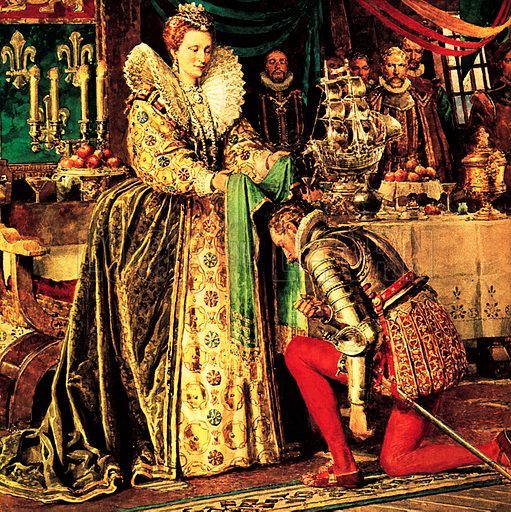
The Virgin Queen adored her audacious sea dogs
Queen Elizabeth gazed fondly at the boldest and most popular of her sea captains, Francis Drake. He had just returned from a four-year, round-the-world voyage, with a vast horde of Spanish treasure in his ship's holds. There, in 1580, on the deck of his ship, the Golden Hind, Elizabeth Knighted Francis Drake. This represented a further deterioration in the fraught relationship between England and Spain. It showed Elizabeth gathering about her the type of men she would need later to destroy the great navy Philip of Spain was building.

A triple portrait of three Elizabethan explorers: on the left is John Hawkins, Drake in center, Cavendish on the right.
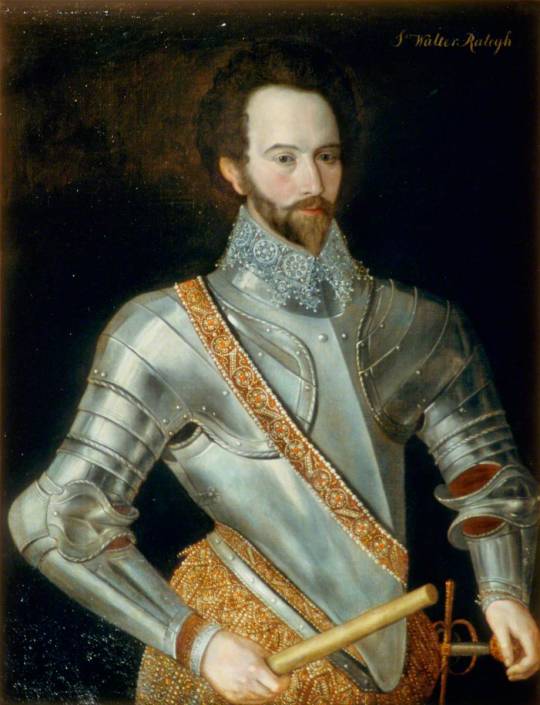
Sir Walter Raleigh, one of the Queen's favorites.
Within a decade, Britain and Spain were at war, and Drake was fighting against the Armada. The issue which finally provoked that war was the central one of Elizabeth's reign. The period was one of great religious strife. The protagonists were the Catholic church and the Protestants.
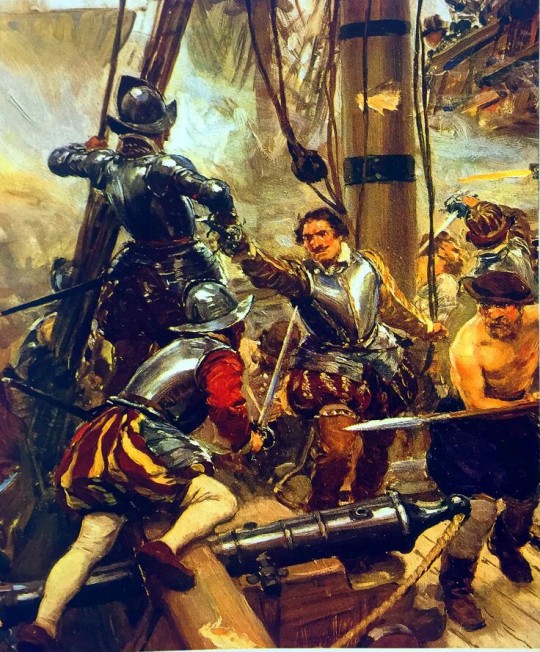
Drake; boarding a Spanish ship.
The great question facing Elizabeth was whether to take a firm Protestant stand, or bring the Church back to what it had been in Henry VIII's time, Catholic in its teachings but without subservience to the Pope. Elizabeth tried to please all her subjects, preserving Protestantism while at the same time refusing to persecute Catholics.

(Cate Blanchett) Elizabeth: 'The Golden Age' 2007 movie
The Catholics Church was determined to win back heretics and conquer the world for Catholicism. Philip II of Spain fully shared these aims. He ruled Spain, Portugal, the Netherlands and many colonies in the Americas.

Spain was so aggressive that Elizabeth had to be very careful. A wrong move could have plunged England into a disastrous war. Elizabeth was determined that if war were to happen, it would do so when England was ready. To this end, she ordered the building of a new navy under the supervision of Sir John Hawkins.

Elizabeth was an astute, well educated woman, who had an almost instant grasp of any situation. She never married. Early in her reign, English privateers began preying on Spanish shipping. England was not then at war with Spain, so these acts were piracy. But Elizabeth, despite complaints by the Spanish crown, did very little to punish or discourage the freebooters who went gaily on with their daring expeditions.
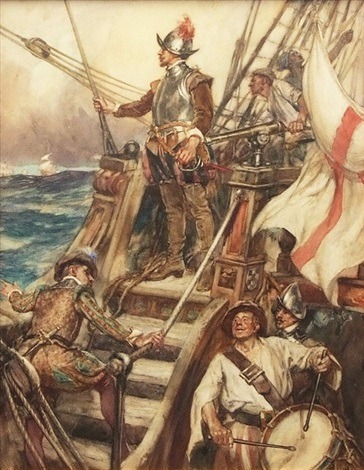
Sir Francis Drake surveying the Armada.
The Catholic-Protestant struggle intensified when the Pope released Elizabeth's subjects from their duty of obedience to her. This meant that the Catholics looked to Mary Queen of Scots, a Catholic queen, to provide them with leadership. There were many plots to remove Elizabeth and put Mary in her place. After the most serious of these plots was uncovered, Elizabeth very unwillingly signed a death warrant for Mary, who was executed.

'Mary, Queen of Scots' - Maria Stuarda goes to the gallows.
Mary's death worsened relationship with Spain to a point which made war inevitable. Spain speeded up her preparations and in 1588 launched the Armada against England. However. The Spanish fleet proved no match for the English navy. The English ships were far more manoeuvrable. Added to which, the English had developed grea superiority in gunnery.
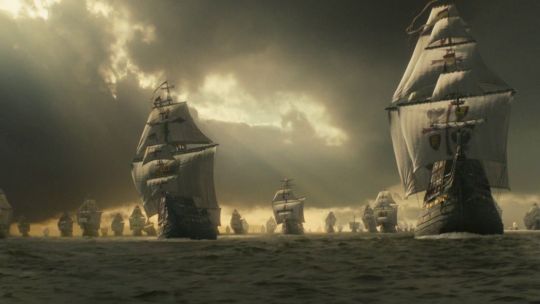
The effect on the uge, slow-moving Spanish ships was devastating. The Spanish plan had been to establish superiority at sea and then to disembark an army in England to dethrone Elizabeth. This was not to be. The parts of the Armada which escaped Elizabeth's navy were torn to shreds by storms and wrecked all the way from the Channel to the Scottish coast. After 1588, Englishmen launched out on enterprises which were to lay the foundations of the British Empire. There was a new confidence in everyone.
5 notes
·
View notes
Text
1003
survey by --rainboweyes--
When you think of this country, what first comes to your mind?
Argentina:
We have a local brand of canned corned beef called Argentina, so instead of the country I immediately thought of that food. But if I really have to connect this to the country, I also remembered a wrestler called Giant Gonzales; he hailed from Argentina.
Brazil:
Those “Come to Brazil” hashtags that used to trend all the time on Twitter. Brazil had some reallllly loud fanbases; I’m just not sure if they’re still as vocal now.
Canada:
Bret Hart. Also @inchoate-surveys, heh.
Denmark:
I don’t really know anything about Denmark. OH WAIT NO there’s Legos, so we’ll go with that.
England:
I honestly thought of their dishes first since I find them rather unique and super different from the Asian dishes I’m used to. We don’t really use beans or make a lot of puddings and pies, but I think they’re all interesting.
France:
Escargot and baguette lol. I’m constantly thinking of food, guys; what a shocker. Also the movie Funny Face since most of it was set in France.
Germany:
Sauerkraut and long words.
Hungary:
I always confuse Hungary with Germany, but the difference is I don’t know a single thing about Hungary. So I don’t actually know how to answer this haha oops, sorry.
Ireland:
Niall Horan HEHE. Also the wrestlers Becky Lynch and Sheamus. Ireland’s got a lot of talented folks.
Italy:
@justsurveys (:D), Lizzie McGuire, the movie Roman Holiday.
Jamaica:
I also first thought of a wrestler. His name is Kofi Kingston and I remembered him because at one point in his career he was packaged to have a Jamaican gimmick even though he’s actually Ghanian, just because of his race and the fact that he had dreadlocks. Like seriously? Classic example of WWE being racist and stereotypical...ugh. It’s truly hard to vouch for them sometimes.
Japan:
The brutally honest first thing I thought of wasssss how they took over my country for a few years and subjected thousands of women and children to various forms of torture before killing them.
Korea:
Korean food :( Man I miss having jjajangmyeon.
Libya:
Their old flag, which was just entirely green. No designs, no stripes, no other colors. Just a good ol’ green flag.
Morocco:
I think of Marrakesh and how colorful the place is. I’d love to go someday.
Norway:
Northern lights.
Poland:
The current Pope. < OMG editing this answer. The Pope I was thinking of was John Paul II, the actual Pole. Pope Francis is from Argentina lmaooooo so sorry
Romania:
I honestly can’t tell you a single thing. Slowly starting to realize that I’m not as good in geography as I thought I was, ha.
Russia:
Onion domes, I think that’s what they’re called.
Spain:
When I think of Spain I always immediately think of the unfinished church, Sagrada Familia is what I think it’s called, if I remember correctly. It’s in my bucket list of places to see, for sure. Then there’s also the 333 years of colonization, but I’m not feeling bitter enough tonight to rant about that.
Tunisia:
Not a clue. I’m bringing my ass to read more about other countries after this.
Turkey:
Gabie, because she has Turkish blood.
Uganda:
That Joseph Kony documentary that blew up nearly a decade ago. I’m pretty sure that was based in Uganda.
United States of America:
Trump, Target, cheeseburgers, elderly people on scooters, those machines at the store that count your coins for you, more cheeseburgers.
United Kingdom:
The royal family, Black Mirror, accents that sound fancy.
Australia:
Barbecue, kangaroos, deserts, Vegemite.
New Zealand:
I thought of my relatives who live there. Also Lord of the Rings.
List 3 movies you like in each genre.
Action:
Eugh, I hate this genre. Wonder Woman is probably the only action movie I ever really enjoyed.
Comedy:
Can romcoms count? I like The Proposal, Ferris Bueller’s Day Off, andddddd This Is Spinal Tap.
Drama:
Room, Revolutionary Road, Requiem for a Dream.
Fantasy:
Huge pass.
Horror:
Midsommar, The Shining, (the original) Carrie.
Kids/Animated:
Toy Story, Finding Nemo, Tangled.
Romance:
Portrait of a Lady on Fire, Carol, Two for the Road.
Sci-Fi:
2001: A Space Odyssey(!!!), The Martian, Interstellar.
Thriller:
Misery, Black Swan, Gone Girl.
Western:
Not my cup of tea. The only thing I could think of is Breaking Bad, and that’s not even a movie.
Answer just in numbers.
Number of brothers you have:
1.
Number of sisters you have:
Also 1.
Number of the house you live at:
Eh.
Number of close friends you have:
Off the top of my head, 3.
Number of pets you have:
2.
Number of times you shower a week:
6 or 7.
Number of concerts you've been to in your life:
Too many to count if I include local gigs at schools. But if we’re only referring to bigger acts held in arenas or stadiums, 4.
Number of cars your household has:
3.
Number of serious relationships you've been in:
1, but we dated twice.
Number of movies you've seen at the cinema this year:
Hahahaha
Number of people who live in your house:
5, including myself.
Number of plug sockets in the room you're in now:
4.
Some more randomer questions.
What food do you have cravings for the most?
My cravings are always changing, though. Right now, it would be sushi and takoyaki. We actually just had both last night for dinner, but we devoured them SO fast and now I’m seeking them out again.
What TV shows do you hate to miss on TV?
I’m not that attached to any show. I used to religiously follow WWE Raw and The Walking Dead and always wanted to watch both live as often as possible, but those days are long gone.
What do you tend to lose the most?
My appetite. As for actual items...probably pens.
The last time someone shouted at you - why were they shouting?
It’s been a while since that happened, so I don’t remember.
Would you rather have a cactus or a bonsai?
Cactus. I heard taking care of bonsai trees is quite complicated, and I just know I’d kill it within a day or two, if not a lot shorter.
What scary story freaks you out the most?
Not really in the mood to think of an answer to this considering it’s 1:07 AM and dark as fuck in my room D:
Are you better with gadgets or cooking?
Probably gadgets, but just barely.
How would you rate your own looks? Personality?
I hate deciding on things about me. I don’t want to hype myself up too much but I don’t want to drag myself down either lol
What accent is the most attractive?
Some English accents are very pleasant to the ear.
Do you get annoyed when people spell your name wrong?
Not for the most part since I have the more uncommon spelling anyway. But if someone is talking to me on like Messenger or Viber where my name is blatantly stated and spelled out and they still misspell it, then I get peeved.
5 notes
·
View notes
Photo

19th March >> Fr. Martin’s Gospel Reflections / Homilies on Luke 2:41-51 for The Feast of Saint Joseph, Husband of the Blessed Virgin Mary: ‘They did not understand what he meant’.
Feast of Saint Joseph, Husband of the Blessed Virgin Mary
Reflections (10)
(i) Feast of Saint Joseph, Husband of the Blessed Virgin Mary
On the 8th December, Pope Francis issued an Apostolic Letter called “With a Father’s Heart”, in which he recalls the 150th anniversary of the declaration of Saint Joseph as Patron of the Universal Church. To mark the occasion of this Apostolic Letter, Pope Francis proclaimed a “Year of Saint Joseph” from 8th December 2020, to 8 December 2021. In his Apostolic Letter, the Pope describes Saint Joseph in a number of very striking ways – as a beloved father, a tender and loving father, an obedient father, an accepting father; a father who is creatively courageous, a working father, a father in the shadows. He wrote the letter against the backdrop of the Covid-19 pandemic, which, he says, has helped us see more clearly the importance of “ordinary” people who, although far from the limelight, exercise patience and offer hope every day. In this, the Pope says, they resemble Saint Joseph, whom he describes as “the man who goes unnoticed, a daily, discreet and hidden presence,” and, yet, played “an incomparable role in the history of salvation.” It is true that Joseph is a discreet presence in the gospel story. He doesn’t feature at all during the public ministry of Jesus, suggesting that he may have died before Jesus began his public ministry. However, he was there during the crucial formation years of Jesus’ life. Like any parent, he worried about his young son growing up. In today’s gospel reading, we find Joseph and Mary worried when they discovered their son was lost. When they finally found him, the young Jesus said to them, ‘Did you not know that I must be busy with my Father’s affairs?’ When Jesus said, ‘my Father’, he was referring to God not Joseph. Joseph had to learn to let go of his son Jesus to God his heavenly Father’s plan for his life, even though that often left him confused, as in today’s gospel reading, ‘they did not understand what he meant’. Joseph had an important role to play in Jesus’ life, but he had to let him go to God from Jesus’ early years. Joseph’s life reminds us that we all have some role to play in God’s greater purpose. There is something we can do, no one else can do. We are often called to be a Joseph figure for others, being there for them but knowing when to let them go to God’s purpose for their lives.
And/Or
(ii) Feast of Saint Joseph, Husband of the Blessed Virgin Mary
It is strange how Christian art has tended to portray Joseph as an old man, more like Jesus’ grandfather, than his father. One striking exception to this is a painting of Joseph by the Spanish artist, El Greco. He depicts Joseph as a vigorous young man, with Jesus clinging to his legs. In that painting Joseph is portrayed as a strong figure, trustworthy and protective. This is much closer to the portrayal of Joseph in the gospels than the usual elderly depiction of him. The gospel reading this morning suggests that although Joseph, the young father, was protective of his young son, he also struggled to understand him at times. Having anxiously searched for Jesus with Mary, Joseph finally finds him in temple, only to be told that by Jesus that he must be busy with his Father’s affairs. Joseph was beginning to learn that there was someone else in his young son’s life whom he called ‘Father’, and to whom he had a stronger allegiance that he had to his earthly parents. Joseph discovered early on that he would have to let his son go to a greater purpose than what he wanted for him. As such, Joseph could serve as an inspiration, a reference point, for all parents who have to work through that difficult task of learning to let go of their offspring.
And/Or
(iii) Feast of Saint Joseph, Husband of the Blessed Virgin Mary
This morning’s gospel reading gives us a mini portrait of Joseph. We are told that every year Joseph and Mary used to go to Jerusalem for the feast of Passover. Joseph, along with Mary, was a devout Jew. The Temple in Jerusalem had an important place in his life. It was the place where God was believed to be present in a special way. Like many faithful Jews, Jesus went up to the Temple in Jerusalem for the great Jewish feasts, such as the Feast of Passover. On this occasion when Jesus was twelve years old, little did Joseph know that Jesus would be crucified by the Romans on the feast of Passover about twenty years into the future. In bringing his son with him to Jerusalem for the great feasts, Joseph was initiating his son into his own Jewish faith, passing on to his son his own religious traditions, beliefs and practices. Joseph was called by God to be a human father to Jesus, to be the best father possible for Jesus. This was a great privilege, but the gospel reading suggests that it was also a very particular challenge, one that made great demands on him. That challenge for Joseph is captured in the exchange between Mary and Jesus. Mary says to her son, ‘see how worried your father and I have been, looking for you’. Jesus replies to her, ‘Did you not know that I must be busy with my Father’s affairs?’ Jesus spoke as one who had another Father than Joseph, a heavenly Father and it was the affairs of his heavenly Father that had to take priority over the concerns of his earthly father. This must have been very difficult for Joseph to come to terms with. He had the responsibility of overseeing the upbringing of Jesus and, yet, he had to learn that his son did not belong to himself or to Mary but was subject to a higher authority than theirs. The gospel reading said, ‘they did not understand what he meant’. Joseph is portrayed in the gospel reading as faithful to his calling to care for Jesus, without fully understanding what was going on in the life of his son. Joseph can be an inspiration to all of us, who are also called to be faithful to the Lord without always fully understanding the Lord to whom we seek to be faithful. Like Joseph we are called to give our heart to the Lord, even though our reason may never fully understand him.
And/Or
(iv) Feast of Saint Joseph, Husband of the Blessed Virgin Mary
Today we celebrate the feast of Saint Joseph. We know relatively little about Joseph. In the gospel of Matthew, when Jesus preached for the first time in his home town of Nazareth, those who knew him asked, ‘Is not this the carpenter’s son?’ Jesus was known to them as the son of the carpenter, the son of Joseph. Joseph had a skill which not everybody in Nazareth had; he could make useful things from wood. He used his skill to provide for his family, including his son Jesus. Jesus would go on to provide for many people in the course of his public ministry. He gave everything he had, including his very life, for God’s people, for all of us. Yet, before Jesus could provide for others, he needed to be provided for, and Joseph played a key role in providing for him. With Mary, Joseph made it possible for Jesus to get to the point where he could leave home a fully formed adult and begin in earnest the work that God gave him to do. Jesus was able to do his work in Galilee and Judea because Joseph did his work in Nazareth. Joseph’s work might seem insignificant compared to the work Jesus went on to do and still does as risen Lord. Yet, Joseph’s work was just as important because without Joseph’s work, Jesus would not have gone on to do the work of God. Joseph teaches us the importance of doing what we have to do as well as possible, even if what we are doing seems of little significance in the greater scheme of things. We are all interdependent. If we do what we have to do as well as we can, we make it easier for everyone else to do what they are called to do. Everything we do has greater significance that we realize. We all have vital roles to play within God’s greater purpose. We are all called to do God’s work, at every stage of our lives, each of us in our own particular way.
And/Or
(v) Feast of Saint Joseph, Husband of the Blessed Virgin Mary
Joseph does not appear in the gospels during the public ministry of Jesus. His presence in the gospels is confined to the first two chapters of Matthew and of Luke which concern the birth and early childhood of Jesus. Yet Joseph is referred to during Jesus’ public ministry in relation to Jesus. Later on in Matthew’s gospel the people of Nazareth ask of Joseph, ‘is not this the carpenter’s son?’ Apart from that detail about Jesus being a carpenter we know very little else about him. However, this morning’s gospel reading from Matthew describes Joseph as a ‘man of honour’, or a ‘just or righteous man’. He is just in that he lives as God commands him to live; he does the will of God and, so, is a good and compassionate man. When he hears God call him to take Mary home with his wife, he does so, in spite of his earlier confusion as to how best to deal with Mary’s expected pregnancy. He is portrayed as someone who seeks God’s will in the complex situations of life. He does not always know how best to act but he leaves himself open to God’s guidance and direction and faithfully responds to God’s promptings. He lives that call of Jesus that is to be found later in Matthew’s gospel, ‘Strive first for the kingdom of God and his righteousness’.
And/Or
(vi) Feast of Saint Joseph, Husband of the Blessed Virgin Mary
There is a wonderful painting of Saint Joseph by the Spanish artist El Greco. In it Joseph is a vibrant young man and the child Jesus is holding on to one of his legs. The sense we get from that painting is of Joseph as a strong, warm, noble presence in the life of the child Jesus. He had a very important role to play in the life of his young son. He may well have died before Jesus began his public ministry because he only appears as a character in the gospels in the opening chapters of Matthew and Luke, when Jesus is a child. Joseph reminds us that the Lord often asks us to play some important role in the life of another for a period of time. Jesus moved on from Joseph because he had to be busy with his Father’s affairs, his heavenly Father’s affairs. Having played his vital role in the life of his son, Joseph had to let him go. When we have played the role in the life of another that only we can play, very often we too are then asked to let them go, and that can be painful as it must have been for Joseph. It is very often there that love meets the cross.
And/Or
(vii) Feast of Saint Joseph, Husband of the Blessed Virgin Mary
Joseph is often depicted as an old man in Christian art and sculpture. Yet, he was obviously a very young man at the time of Jesus’ birth, as young as Jesus’ mother Mary, the woman to whom Joseph was married. It can’t have been easy being the father of such a special child. This morning’s gospel reading portrays something of the struggle that being the parent of Jesus entailed. When Jesus’ parents eventually found him in the Temple after much anxious searching, Mary said to her young son, ‘See how worried your father and I have been?’ In reply Jesus said, ‘Did you not know that I must be busy with my Father’s affairs’. When Mary referred to ‘your father’ she meant Joseph; when Jesus said ‘my Father’ he meant God. Luke suggests that because Jesus belonged to God from an early age, his parents had to learn to let him go much sooner than would have been the norm. Joseph had to learn that his son had another Father, a heavenly Father, to whom he was totally dedicated. Yet, Joseph remained a full father to his son in the earthly sense, fulfilling all the roles that would be expected of a father in that culture. Very early into his son’s life, Joseph had to learn to love his son while leaving him free for whatever God was asking of him. In that sense, we can all look to Joseph as someone who embodies a love that is generous without being possessive, faithful without being controlling.
And/Or
(viii) Feast of Saint Joseph, Husband of the Blessed Virgin Mary
Saint Joseph has a somewhat low profile in the gospel story. He doesn’t feature at all during the public ministry of Jesus. He is present in the gospel story only in the context of the childhood of Jesus. This may suggest that Joseph had died before Jesus began his public ministry at the age of thirty or so. Yet, Joseph must have been a hugely significant figure in the early years of Jesus. In the Jewish culture of Jesus’ time, it was the father who passed on the religious traditions to the children. It was the father who taught the children how to live in accordance with God’s will as revealed in the Scriptures. This role of the father is reflected in the earliest document of the New Testament, the first letter of Paul to the Thessalonians. There Paul compares his role in the church of Thessalonica to that of a father in a family, ‘we dealt with each of you like a father with his children, urging and encouraging you and pleading that you lead a life worthy of God’. It was above all from Joseph that Jesus would have received instruction in his Jewish faith. Through Joseph, he came to know the God of Abraham, Isaac and Jacob. Jesus, of course, was no ordinary child. He had a unique relationship with the God of Israel; he understood himself to be the son of Israel’s God. This must have complicated Joseph’s task of bringing up his son in the practice of the Jewish faith. This is evident in today’s gospel reading from Luke. When his parents eventually find the boy Jesus in the Temple, his mother says to him, ‘See how worried your father and I have been, looking for you’. Jesus replied, ‘Did you not know that I must be busy with my Father’s affairs?’ By ‘your father’ Mary meant Joseph. By ‘my Father’ Jesus meant God. The gospel reading suggests that from an early age Jesus’ heavenly Father had a greater influence on him than his earthly father. This must have left Joseph confused and disturbed at times. According to today’s gospel reading, Jesus’ parents ‘did not understand what he meant’ when he spoke about being busy with his Father’s affairs. Joseph struggled to discern God’s will for his son. He came to see that what he wanted for his son was not necessarily what God wanted for him. He had to learn to let go of his son to God’s greater purpose for him. We can all identify with Joseph’s struggle in this regard. We too sometimes struggle to surrender to God’s purpose for our lives and for the lives of those who are close to us. God’s way of working in our own lives and in the lives of others can seem a mystery to us and, sometimes, like Joseph, we have to learn to let go to a mystery we do not fully understand.
And/Or
(ix) Feast of Saint Joseph, Husband of the Blessed Virgin Mary
The image of the twelve-year old Jesus sitting among the doctors of the law in the Temple, which we find in today’s gospel reading, is a striking one. It doesn’t say that Jesus was teaching these doctors of the law. Rather, he was listening to them and asking they questions. He was receptive to what they were saying. No doubt Jesus was also receptive to what Joseph said to him. In the Jewish family, the father was the one responsible for passing on the religious tradition to the children. Joseph may not have been a doctor of the law, but he was a teacher within his own home. Yet, the gospel reading suggests that at twelve years of age, Jesus was moving on from receiving the wisdom of his superiors to taking his own path in life. Having travelled with his family from Nazareth to Jerusalem, for the feast of Passover, he decided not to travel back with them, apparently without informing any member of his extended family. Mary and Joseph ended up searching for him everywhere. Eventually, they decided to head back to Jerusalem where they did eventually find him in the Temple. Their disappointment in Jesus and the distress he caused them is very evident in the question Mary put to him. Yet, his answer to their question caused them a different kind of distress. ‘Did you not know that I must be busy with my Father’s affairs?’ They didn’t understand what he meant. By, ‘my Father’s affairs’, the boy Jesus was not referring to his father Joseph, but to his heavenly Father, God. If Jesus was learning from the doctors of the law, Joseph had his own lesson to learn from his young son. He was beginning to realize that his influence on his son would have to take second place to God’s influence. He and his wife, Mary would have to learn to let Jesus go to God’s purpose for his life. We can learn from Joseph that gentle art of letting go, of surrendering those we cherish to God’s purpose for their lives, even though it may leave us with a great sense of loss. Joseph learnt to allow God to be God in his own life and in the life of his Son. We pray for something of that same generosity of spirit that Joseph clearly had.
And/Or
(x) Feast of Saint Joseph, Husband of the Blessed Virgin Mary
In the first reading, Saint Paul refers to Abraham as ‘the father of all of us’. For Paul, Abraham was the father of all believers because he was a man of faith who trusted in God’s word of promise. Just as the Jewish people look back to Abraham as their father in faith, so too can we who believe in Jesus. Today, we celebrate the feast of Saint Joseph. As a man of faith, deeply rooted in the Jewish tradition, he certainly would have looked to Abraham as his father in faith. Joseph was unique among the spiritual children of Abraham in being the father of Jesus whose relationship with God was of a different order to Abraham’s relationship with God. According to the gospels, Jesus was known as ‘the carpenter’s son’. There are many titles for Jesus in the gospels and in the rest of the New Testament, but the title, ‘the carpenter’s son’, is, perhaps, the most human. Joseph provided for Mary and his son Jesus by working as a carpenter. He helped to provide a stable home for Jesus where Jesus could grow in ‘wisdom and in stature and in favour with God and people’, according to the gospels. Joseph seems to have died before Jesus began his public ministry because he never features in the story of Jesus’ public, adult, life in the gospels. By the time Jesus began his public ministry, Joseph’s work was done. Mary, we know, lived on at least until the feast of Pentecost at which the Holy Spirit came down upon her and the disciples. Joseph reminds us that the Lord has some work for all of us to do. Very often, our work, like Joseph’s, consists in creating a space for God to work in the life of someone else. That work will often involve a letting go of others, a letting be. That is what we find Joseph being called to do in today’s gospel reading. He had to let Jesus go to God the Father’s work in the life of his young son. ‘I must be busy with my Father’s affairs’, Jesus said, meaning God, not Joseph.
Fr. Martin Hogan.
1 note
·
View note
Photo
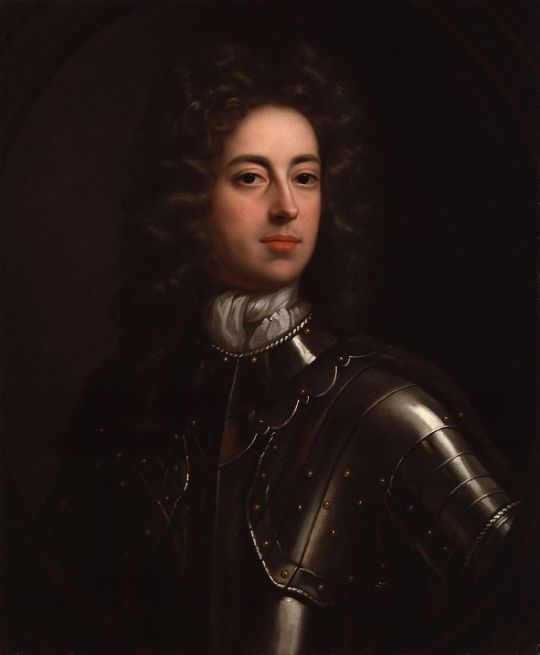
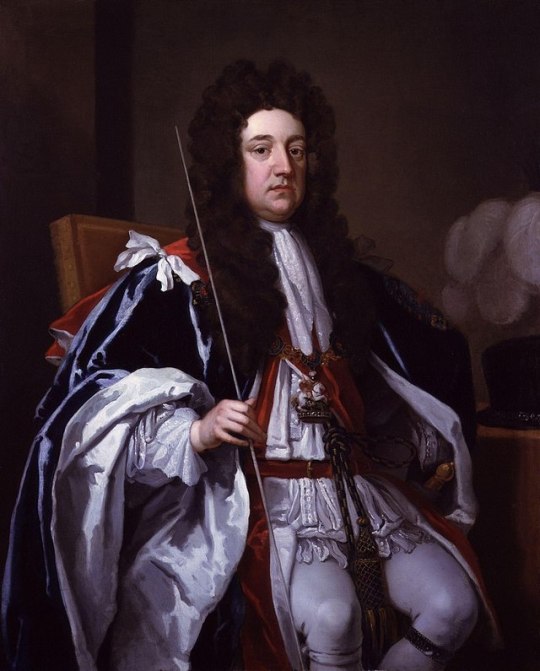


The men of ‘The Favourite’
John Churchill, 1st Duke of Marlborough (1650 - 1722) - Sarah’s husband and the great love of her life, John rose through the ranks of the restored King Charles II’s court from mere page to one of the greatest statesmen and military commanders of his age. This was, in part, due to his own political savviness, but he and Sarah worked as a team to advance their station in different spheres of the royal court. John was best friends with Queen Anne’s father, King James II (formerly the Duke of York), in his youth, but at the last minute, he defected to the side of Anne’s brother-in-law and sister, William and Mary, when they came to depose James II on account of his Catholicism in 1688. His skill as de facto leader of the Allied forces during the War of the Spanish Succession, which is often mentioned in the film, made him legendary and he was not only given the title of Duke of Marlborough for his efforts, but made a Prince of the Holy Roman Empire and the first and only non-royal and non-episcopal country house to be granted the title of palace (Blenheim Palace in Oxfordshire). Interestingly, contemporaries noted that John was irresistible to both women and men....make of this what you will.
Sidney Godolphin, 1st Earl of Godolphin (1645-1712) - Sidney Godolphin was indeed a life long friend of the Churchills and he, too, had begun his rise through the ranks of favour at the court of King Charles II. He had been one of Charles II’s favoured members of the royal household. He had, like John Churchill, been loyal to James II until the last minute and under the joint monarchy of William III and Mary II, and later, under the reign of Queen Anne, he rose to become the Lord High Treasurer. Godolphin was actually a moderate Tory, just like John Churchill, but both he and Churchill formed an alliance with the so-called ‘Whig Junto’ (court Whigs) that led to their dominance and opposition against the High Tories, led by Robert Harley. Godolphin did eventually lose his place after the Churchills fall from grace and died soon after. He harboured a heartache all his life, too: during the Restoration, when he was a young man, he had fallen in love with a court beauty and Maid of Honour to Queen Anne’s mother. Her name was Margaret Blagge and when they married, it was a love match. Unfortunately, Margaret died in childbirth at the age of 26, in 1678. Their son, Francis Godolphin, survived and went on to marry Lady Henrietta Churchill, the eldest daughter of John and Sarah. Sidney never remarried, and was left quite desolate after the death of Margaret.
Robert Harley, 1st Earl of Oxford (1661-1724) - Harley’s political career is a lengthy and complicated one. He actually began as a Whig, though he later abandoned many of their principles (but never their staunch loyalty to the Protestant faith). He became the leader of the Tory and ‘Old Whig’ side of the House in opposition to the court Whig Junto, headed by Godolphin and Churchill. In the reign of Queen Anne, because of her Tory sentiments, he became essentially her chief minister (referred to as ‘Prime Minister,’ though the first official Prime Minister would be Robert Walpole two decades later). He opposed Churchill and Godolphin’s Whigs in everything and became a master of political spin, promoting and patronising the careers of writers like Daniel Defoe, Alexander Pope, Jonathan Swift and John Gay, on the condition that they write political spin in his favour. He also was a cousin of Queen Anne’s new favourite, Abigail Masham, and probably was at least some of the brains behind encouraging Abigail to seek the Queen’s favour. The chief achievement of his political career was negotiating the Treaty of Utrecht which brought an end to the War of the Spanish Succession. In the reign of George I, Queen Anne’s successor, however, he was imprisoned in the Tower of London for two years on charges of treason. There were several assassination attempts on his life, one of which was thwarted only because he liked to wear fine, fancy clothes and the knife that stabbed him, consequently, could not penetrate his skin.
Samuel Masham, 1st Baron Masham (1678-1759) (unfortunately, there are no surviving portraits or images of Samuel) - Samuel Masham was indeed one of Queen Anne’s equerries (meaning he took charge of the horses!) but had been a member of her Royal Household for a while prior. Samuel Masham himself believed that the match between himself and Abigail, who he met in 1704 when she became Anne’s Lady of the Bedchamber, was predicated on love, though Robert Harley probably encouraged him to court Abigail as she was rising in the Queen’s favour. He benefitted quite a lot from his wife’s position as the Queen’s favourite. He became a Brigadier General in the army, an MP and was given a peerage. On the death of Queen Anne, Abigail retired from public life and would become quite a staunch Jacobite and opponent of Anne’s Hanoverian successors. Samuel, however, did quite well at the court of King George I, clearly not harbouring the same Jacobite sympathies as Abigail, and long outlived his wife.
William, Duke of Gloucester (1689-1700) - Though we never see William, as he had died soon before the events in the film take place, his spectre is everywhere in the movie. He was not Queen Anne’s eldest son, but he was her only child to (briefly) survive infancy. He had always been quite a sickly boy, though always lively and good-natured. He had started having convulsions from from the age of three weeks old, possibly on account of meningitis, but more probably on account of the fact that he suffered from hydrocephalus. He was often subjected to quite unpleasant treatments and medicines, but he was loved dearly by Anne and her husband, Prince George of Denmark, who moved with him to Kensington in the hope that the fresh air would do him good. William was often driven out in a carriage, pulled by Shetland ponies, as a treatment. William’s education was a little delayed, on account of the fact that it took him a while to learn how to speak properly, but as the heir to Anne’s brother-in-law, William III, and Anne herself, he was given a rigorous political and religious education. Whilst living in Kensington, he befriended another child, a young Welsh boy named Jenkin Lewis, who became one of his closest companions and who wrote extensive memoirs about William, in his later life (thanks to Jenkin, we know that William was given his own miniature army of young boys to command!). On the 24th July 1700, a party was held for William’s 11th birthday at Kensington Palace. He danced, delighted in the music and ate a lot of sweet food. Near the end of the party, he began to complain of fatigue, a temperature and a rash. It took a while for physicians to attend him and they could not agree on a diagnosis and subsequently, little William was put through many horrible treatments, including bleeding and blistering. One of the physicians said to his colleagues that ‘[they had] destroyed him and [they may] finish him.’ William was in great agony from both his illness and the treatments that had been administered, and he complained of this to his mother, Anne, who remained constantly at his bedside. When he was in the last few hours of his life, he could not swallow, he was convulsing from the pain, had a splintering headache and was slipping in and out of delirium. He died on the 30th July, 1700, with both his parents beside him. Anne was so prostrate with grief at his death that she immediately fainted and in the coming months, she locked herself up in her chamber, only being induced out when she was able to be carried to the garden for air and respite from her thoughts. His presence in the movie is in Anne’s distaste of music and dancing (remember, he had essentially become fatally ill at his birthday party, though modern physicians think he died of strep throat and pneumonia), her depressive eating of cake and the pre-eminence of her pet rabbits above all her royal favourites. Sarah had been less than sympathetic upon William’s death, believing that Anne took far too much time to mourn him.
60 notes
·
View notes
Photo

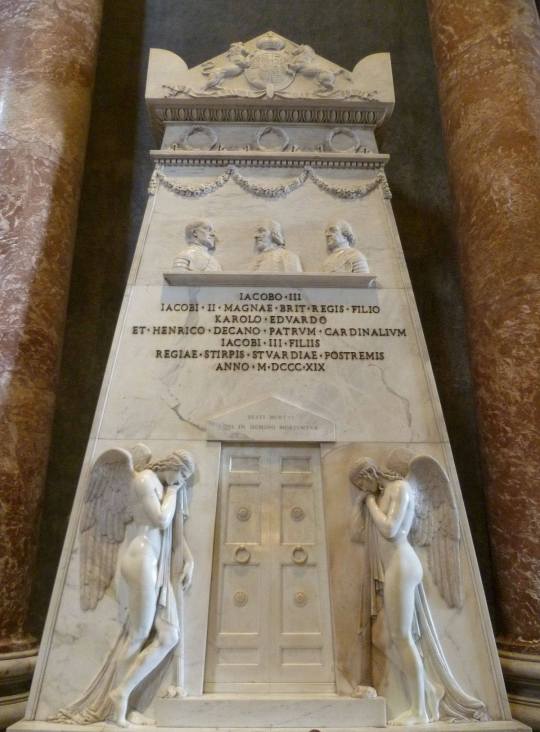
January 1st 1768 saw the death of James Francis Edward Stuart, in Rome.
Born after nine previous children died either at birth or shortly after and a tenth who died at age four, a rumour, likely started by Protestant partisans, was almost immediately spread that a living child had been smuggled into the birthing chamber in a warming pan after the royal child had been born dead. At birth he was created 1st Duke of Rothesay, styled as Earl of Chester and Prince James of Wales. He was also created 1st Duke of Cornwall.
Fearing another Roman Catholic monarch, a Protestant group invited James II's Protestant daughter by his first marriage, Mary, to take the throne, supplanting both her father and half-brother. Her acceptance resulted in what became known as the Glorious Revolution of 1688.
James was raised in exile in France where he became the focus for Jacobites hopes. Upon his father's death in 1701, he declared himself king and was recognized as the heir by several Roman Catholic monarchs, but was attainted for treason by Act of Parliament in March 1702 in Britain and his titles were forfeited under British law.
He attempted an invasion of Britain in March 1708, but his fleet was driven off. Another attempt was made in 1715 when he achieved landfall in Scotland but had missed the crucial Battle of Sherriffmuir disappointed by the lack of support instead of attempting a planned coronation at Scone, he retreated back to France.
By this time the French were at peace with Britain and he was no longer welcome in the country. He was invited by Pope Clement XI of the Palazzo Muti to make Rome his residence. In September 1719, he married Maria Sobieski and with her had two sons, Charles Edward and Henry. He presided over his Roman Jacobite court for the remainder of his life.
He died at age 77 in Rome. He was buried within the Vatican City, in what we know as The Monument to the Royal Stuarts. The marble monument is by Antonio Canova, the most celebrated Italian sculptor of his day. It is in the form of a truncated obelisk. It carries profile portraits of the three exiled princes, and the following inscription:
IACOBO·III
IACOBI·II·MAGNAE·BRIT·REGIS·FILIO
KAROLO·EDVARDO
ET·HENRICO·DECANO·PATRUM·CARDINALIVM
IACOBI·III·FILIIS
REGIAE·STIRPIS·STVARDIAE·POSTREMIS
ANNO·M·DCCC·XIX
(To James III, son of King James II of Great Britain, to Charles Edward and to Henry, Dean of the Cardinal Fathers, sons of James III, the last of the Royal House of Stuart. 1819)
Below the inscription are two weeping angels, symbolising the lost hopes of the exiled Stuarts.
22 notes
·
View notes
Text
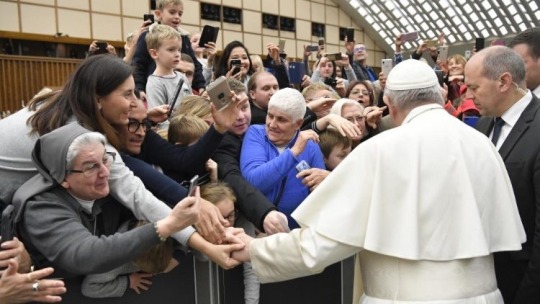
11th December >> (@ZenitEnglish) #PopeFrancis General Audience Address in St Paul VI Hall: St. Paul, Suffering Witness of Risen One (Full Text) ‘Today, many Christians in the world, in Europe, are persecuted and give their life for the faith, or are persecuted with white gloves, namely, left aside, marginalized…’
This morning’s General Audience was held at 9:20 am in Paul VI Hall, where the Holy Father Francis met with groups of pilgrims and faithful from Italy and from all over the world.
Continuing with the series of catecheses on the Acts of the Apostles, in his address in Italian the Pope meditated on the theme: “In a short time you think to make me a Christian!” (Acts 26:28) — Paul is a prisoner before King Agrippa (Biblical passage: Acts of the Apostles 26:22-23).
After summarizing his catechesis in several languages, the Holy Father expressed special greetings to groups of faithful present.
The General Audience ended with the singing of the Pater Noster and the Apostolic Blessing.
* * *
The Holy Father’s Catechesis
Dear Brothers and Sisters, good morning!
In the reading of the Acts of the Apostles, the journey of the Gospel continues in the world, and the seal of suffering marks increasingly Paul’s witness. However, this is something that grows over time in Paul’s life. Paul isn’t only the evangelizer full of ardour, the intrepid missionary among the pagans, who gives life to new Christian communities, but he is also the suffering witness of the Risen One (Cf. Acts 9:15-16).
The Apostle’s arrival in Jerusalem, described in chapter 21 of the Acts, unleashes a ferocious hatred in his regard; they reprimand him: “But he was a persecutor! Don’t trust him!” As it was for Jesus, for Paul also Jerusalem is the hostile city. Going to the Temple, he is recognized; <he is> led outside to be lynched, and saved in extremis by the Roman soldiers. Accused of teaching against the Law and the Temple, he is arrested and begins his prisoner’s pilgrimage, first before the Sanhedrin, then before the Roman Procurator in Caesarea and finally before King Agrippa. Luke shows the similarity between Paul and Jesus, both hated by their adversaries, accused publicly and acknowledged innocent by the imperial Authorities and so Paul is associated to his Master’s Passion, and his passion becomes a living Gospel. I <have> come from Saint Peter’s Basilica, where this morning I had an audience earlier with Ukrainian pilgrims from a Ukrainian diocese. How these people have been persecuted; how much they have suffered for the Gospel! However, they didn’t negotiate the faith. They are an example. Today, many Christians in the world, in Europe, are persecuted and give their life for the faith, or are persecuted with white gloves, namely, left aside, marginalized . . . Martyrdom is the air of a Christian’s life, of a Christian community. There will always be martyrs among us: this is the sign that we are following Jesus’ way. It’s a blessing of the Lord, that there be in the People of God, a man or a woman who gives this witness of martyrdom.
Paul is called to defend himself from the accusations and, in the end, in the presence of King Agrippa II, his apologia changes into an effective witness of faith (Cf. Acts 26:1-23). Then Paul recounts his own conversion: the Risen Christ has made him Christian and has entrusted to him the mission among the Gentiles, “that they may turn from darkness to light and from the power of Satan to God, that they may receive forgiveness of their sins and a place among those who are sanctified by faith” in Christ (v. 18). Paul obeyed this charge and did nothing other than show how the prophets and Moses announced what he now proclaims: “that the Christ must suffer, and that, by being the first to rise from the dead, he would proclaim light both to the people and to the Gentiles” (v. 23).
Paul’s passionate witness touches the heart of King Agrippa, who is only lacking the decisive step. And the King says thus: ”In a short time you think to make me a Christian!” (v. 28). Paul is declared innocent, but he cannot be released because he has appealed to Caesar. Thus, the unstoppable journey of the Word of God continues towards Rome. Paul, in chains, will end up here in Rome.
Henceforth, Paul’s portrait is that of a prisoner whose chains are the sign of his fidelity to the Gospel and of the testimony rendered to the Risen One. The chains are certainly a humiliating test for the Apostle, who appears to the eyes of the world as a “criminal” (2 Timothy 2:9). However, his love for Christ is so strong that even these chains are read with the eyes of faith; faith that for Paul isn’t “a theory, an opinion on God and on the world,” but “the impact of the love of God on his heart, [. . . ] it’s love for Jesus Christ.” (Benedict XVI, Homily on the Occasion of the Pauline Year, June 28, 2008).
Dear brothers and sisters, Paul teaches us perseverance in trials and the capacity to read all with the eyes of faith. Let us ask the Lord today, through the intercession of the Apostle, to revive our faith and to help us to be faithful to the end to our vocation of Christians, of disciples of the Lord, of missionaries.
[Original text: Italian] [ZENIT’s translation by Virginia M. Forrester]
In Italian
A warm welcome goes to the Italian-speaking pilgrims. In particular, I greet the Missionaries of Charity; and the parish groups, especially those of Mendicino and of Faro-Fiumicino. In addition, I greet the personnel of the Police Headquarters of Crotone, the Feasts of Mesagne Committee; the delegations of the Municipalities of Introd and of Bolsena; the group of professionals and doctors in Optometry; and the Friends of the Blessed Pellesi Association of San Michele dei Mucchietti-Sassuolo.
Finally, I greet the young people, the elderly, the sick and the newlyweds. Observed next Friday is the Memorial of Saint Lucy, Virgin and Martyr. I wish all of you that the light of the Child Jesus, now on the horizon, may invade your life with His blessing.
[Original text: Italian] [ZENIT’s translation by Virginia M. Forrester]
11th DECEMBER 2019 13:02GENERAL AUDIENCE
1 note
·
View note
Photo


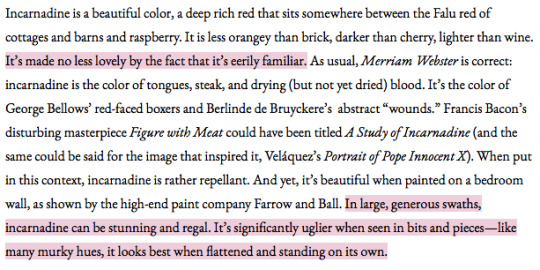


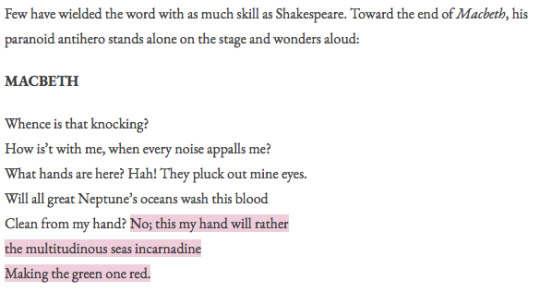
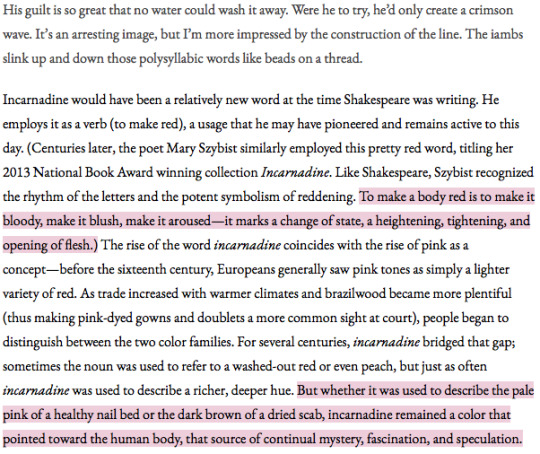
Incarnadine, the Bloody Red of Fashionable Cosmetics and Shakespearean Poetics i. Stag At Sharkey’s, George Bellows, 1909
ii. The Wound, Berlinde de Bruyckere, 2011
iii. Left: Portrait of Pope Innocent X, Diego Velázquez, c. 1650; Right: Figure With Meat, Francis Bacon, 1954
374 notes
·
View notes
Photo

~Henry VII: More Myth than Man - The Red Dragon's Odyssey~
“He was comely personage, a little above just stature, well and straight-limbed, but slender. His countenance was revered, and a little like a churchman, and as it was not strange or dark so neither was it winning or pleasing, but as the face of one well disposed. But it was to the disadvantage of the painter, for it was best when he spoke.” (Francis Bacon)
Although written a century after his death, Francis Bacon’s description of the first Tudor King, is right on the spot. Linda Porter for her part, says the following in her book "Tudors vs Stewarts":
“[He was] A considered person, not given to great public displays of emotion, somewhat ascetic in appearance, not exactly handsome but with an interesting and by no means unattractive face, the whole man only at his most appealing when he was animated. His portraits show that he did, indeed, have something of the churchman about him: a calm and also inscrutability, a sense that you would never entirely know that he was thinking. It gave him an air of authority.”
Henry was formerly the Earl of Richmond, a title he inherited before his birth from his late father, Edmund Tudor, half-brother to the last Lancastrian King, Henry VI. Henry was named after his half-uncle and after he and his direct family died, he went into exile where he spent thirteen years as an 'honored guest' of the Duke of Brittany, Francis II, before spending his fourteenth year in France. The French King and his influential sister, Anne of Brittany, gave Henry funds and men for his campaign against the "usurper", King Richard III. After the Battle of Bosworth, he became King of England. According to one legend, one of his men found the crown lying in a thornbush near the slain Richard III. Some early Tudor motifs depict this, making this legend a popular truth in the minds of his future subjects who grew up knowing nothing else but the version of events that Henry and his descendants gave them.
Archaeological evidence puts to the test some of the claims made by both parties. In his book "Bosworth", Michale Jones, says that most of what the Tudor chroniclers wrote must not be taken at face value since they were written after the outcome of the battle, nonetheless, he does give credence to some contemporary accounts as they corroborate medieval attitudes.
Henry was 28 when he was crowned King of England and Lord of Ireland. Three years older than his granddaughter and last monarch of his dynasty, Elizabeth I, and like her and his other granddaughter, he had already experienced a lot. Aside from his exile, he had escaped assassination and kidnapping attempts from his late father-in-law, Edward IV. At a young age, he learned to trust no one and rely on his wits and those closest to him and blood. He was well-aware of the fact that without his uncle Jasper and mother, he would have never made it this far. He showed his gratitude by giving them titles, lands and positions that made them two of the richest and most influential peers in England.
While his wife was not a political figure like many of her predecessors, she remained a constant figure in his life. He and Elizabeth loved and respected one another and as they swore to do on their wedding day, they were there for each other in sickness and in health. When they lost their firstborn and eldest son, Prince Arthur, Elizabeth of York was the first one to comfort Henry, reminding him of their duty and their youth -that they still had more years ahead of them and could still give the House of Tudor one more heir- and afterwards, Henry did the same for her.
Henry showed a deep appreciation for the land of his birth, Wales, rewarding all of his Welsh commanders and creating new posts for some of them, as well as using the symbol of their flag as part of his royal coat of arms. To this day, the red dragon that represents Cadwalldr and in the Tudor years, came to be associated with the new dynasty, is still the symbol of Wales.
To avoid another recession or economic collapse, Henry continued (albeit improving them) Edward IV's economic policies. Today we often hear about social scientists stressing on employers to make sure that they are in a good place (mentally), otherwise, their decisions could affect the well-being of their employees as well as themselves. This could not be truer for Henry VII. While his successes are commendable; sadly, they are overshadowed by the last years of his reign. Thomas Penn heavily focuses on these last years in his book "The Winter King" and in his documentary of the same name. He lists how Henry became more paranoid and closeted himself from the outside world, coming out only for special occasions. This was due to his personal losses. By 1503, he had lost his uncle, eldest son, wife and baby daughter and was soon to lose his eldest and favorite daughter, Margaret. Named after his mother -whose counsel he still valued-, Henry was close to his eldest daughter but like every royal father, he was well aware that if he wanted the peace between England and Scotland to remain (something that few other English kings achieved) he had to do this small sacrifice. Princess Margaret knew what her duty was and was ready to fulfill her royal obligations. In mid 1503, a few months after her mother died, Margaret left England. Months later she arrived to Scotland where she married King James IV, becoming Queen Consort of Scotland.
Although Henry never saw his daughter again, the two remained close. Distance could not sever their bond anymore than Henry's lament for his dead ones could. The two continued to write to each other until Henry's dying breath in 1509, six years later.
This affectionate persona is often dismissed by writers, because it detracts readers from focusing on the negative aspects they present them with to prove their case that Henry was a tyrant, or, that if he didn't start as one, he surely became one.
But was he a tyrant? What is the truth behind the fiction?
Towards the end of his life, Henry did become paranoid and he did enact policies that bled his country dry; but as it's been pointed out, this was due to the effect his personal losses had on him as well as the threats that still lingered abroad. Though he had rid himself of most Yorkists, including their puppets; there were still some out there whom he feared would be used against him in the same manner as he had been used against Richard III. And unlike his predecessors, including the king he deposed, Henry's claim was tenuous and his successes weren't enough to convince anyone of the validity of his claim, or the legitimacy of his offspring who were the embodiment of York and Lancaster.
This made Henry uneasy and with only one male heir and no spare, Henry became increasingly cautious, seeing enemies everywhere. He was determined to safeguard what remained of his family and protect his only remaining son. By the time he died, the crown was wealthier than it had been in decades. His son, also named Henry, ascended to the throne as a seventeen year old and was crowned months later when he became eighteen.
Henry VIII honored his father's legacy, reminding everyone of his father's victory, his parents' union, and the product of the union: Himself, as the living embodiment of their dream. The perfect union of Lancaster and York from which sprung a new hope who'd brought to England a golden age. And while some did dispute this, most were wise not to say a word unless they wanted to risk their heads at the chopping block or be accused as heretics by His Majesty's inquisitors.
But, concerned with his own legacy, Henry VIII also delivered some clever jabs at his father. In the famous Tudor Dynasty portrait, both Henrys lean next to a pillar with their respective wives -Jane Seymour and Elizabeth of York- at the opposite side, that reads that while Henry VII was amazing, his son was more amazing because he separated from the church -thus freeing England from its shackles that bound it to Rome- and made himself pope, making the authority of a monarch absolute which was more than his father could have ever dreamed of.
Henry VIII was certainly important and by many people's standards, a legend, but so was his father. His father should have never been King of England and yet he became one. Without him, there would have been no Tudors or strong king who would've gotten away with breaking away from Rome and making himself Head of his new Church.*
To loosely quote Chris Skidmore from his book "Bosworth", the odds were stacked against him and he still kept advancing until he reached his ultimate goal and exceeded everyone's expectations. The end result was a mixture of luck, good timing, bad weather, indecision and bad choices on the part of his enemy.
On the 30th of October 1485, Henry Tudor was crowned King of England. Months later he married the beautiful Elizabeth of the House of York whom he had re-legitimized by legitimizing her parents' union that Richard III through parliament had declared unlawful. While his last name died off with his granddaughter, his dream of seeing his dynasty overshadow all others came true. Controversy, success, among all other things, are what continue to make the Tudors one of the most interesting figures in history.
*It was Henry VII's actions to eliminate private liveries that allowed for this. Henry had seen how easy it was for nobles to assemble an army. The Plantagents tried to do this but had little success. They had to keep their nobles content in order to avoid revolt, while others who were less eager to play the role of gracious hosts to them had to keep constant vigilance by placing spies on their households. Henry VII also increased the number of spies and required more tests of loyalty from his noble subjects which his successors, including his grandchildren, imitated, to ensure that no noble would ever overthrow them. This is one of the many reasons why ALL the Tudor Kings and Queen died in their beds instead of the battlefield or poisoned.
Sources: Tudor vs Stewarts by Linda Porter
Tudor by Leanda de Lisle
Wars of the Roses: The Fall of Plantagenets and Rise the Tudors by Dan Jones
Bosworth by Chris Skidmore
Bosworth 1485 Michael K. Jones
Henry VII by SB Chrimes
Tudor Treasury by Elizabeth Norton
Winter King by Thomas Penn
Elizabeth of York by Amy Licence
1 note
·
View note
Text
10 Famous Francis Bacon Paintings
Francis Bacon is considered to be one of the most influential painters of the 20th century. Born in Dublin, Ireland, in 1909, Bacon is known for his bold and emotionally charged paintings that often depict distorted and tormented figures. In this article, we will take a closer look at 10 famous Francis Bacon paintings.
Three Studies for Figures at the Base of a Crucifixion
One of Bacon's earliest and most famous works, Three Studies for Figures at the Base of a Crucifixion was painted in 1944. The painting consists of three panels, each depicting a distorted, almost animalistic figure. The work has been interpreted as a response to the horrors of World War II.
Study after Velázquez's Portrait of Pope Innocent X
Painted in 1953, Study after Velázquez's Portrait of Pope Innocent X is one of Bacon's most famous works. The painting depicts the Pope's screaming face, twisted and contorted, against a deep red background. The work is a powerful example of Bacon's ability to convey intense emotion through his art.
Head VI
Painted in 1949, Head VI is a disturbing portrait of a screaming figure with an open mouth and contorted features. The painting is a powerful example of Bacon's interest in exploring the human condition and the darker aspects of the human psyche.
Figure with Meat
Painted in 1954, Figure with Meat is a disturbing and powerful work that depicts a human figure with a side of beef. The painting is a commentary on the human condition and the way in which we are often seen as nothing more than meat.
Triptych, 1974-1977
Triptych, 1974-1977 is a three-panel work that depicts three screaming figures against a black background. The painting is a powerful expression of Bacon's interest in the themes of death, violence, and isolation.
Study for a Self-Portrait
Painted in 1976, Study for a Self-Portrait is a haunting and emotionally charged work that depicts a distorted and tormented figure. The painting is a powerful example of Bacon's ability to convey intense emotion through his art.
Study for a Portrait of Van Gogh IV
Painted in 1957, Study for a Portrait of Van Gogh IV is a powerful work that depicts a distorted and tormented figure, inspired by the famous Dutch painter Vincent Van Gogh. The painting is a powerful example of Bacon's interest in exploring the human condition and the darker aspects of the human psyche.
Seated Figure
Painted in 1961, Seated Figure is a powerful and emotionally charged work that depicts a distorted figure sitting on a chair. The painting is a commentary on the human condition and the way in which we are often seen as isolated and alone.
Second Version of Triptych 1944
Second Version of Triptych 1944 is a three-panel work that depicts three screaming figures against a black background. The painting is a powerful expression of Bacon's interest in the themes of death, violence, and isolation.
Study of Isabel Rawsthorne Standing in a Street in Soho
Painted in 1967, Study of Isabel Rawsthorne Standing in a Street in Soho is a portrait of Bacon's friend and fellow artist, Isabel Rawsthorne. The painting is a powerful example of Bacon's ability to convey intense emotion through his art.
Conclusion:
Francis Bacon was a painter whose work continues to resonate with audiences today. His bold and emotionally charged paintings, often depicting distorted and tormented figures, have had a profound impact on the art world. Through his art, Bacon explored the darker aspects of the human psyche
Check out our website for buying exhibition posters and Paintings. Merch Fuse.
0 notes